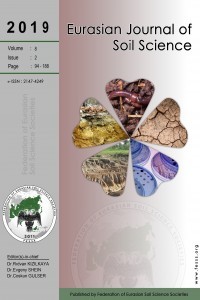
Eurasian Journal of Soil Science
Yazarlar: Gamal S. SWİLEAM, Reda R. SHAHİN, Hamdy M. NASR, Khalid S. ESSA
Konular:Fen
DOI:10.18393/ejss.528851
Anahtar Kelimeler:Soil resistivity,Wenner profiling,Soil moisture,Soil salinity,Mapping,Spatial dependency
Özet: Spatial information about soils generally results from local observations which are destructive and time consuming. Geophysical techniques could help soil mapping since they are non-destructive and fast. Electrical resistivity is interesting for soil studies due to a wide range of values and as it depends on soil characteristics. This work aims to study soil spatial variability using electrical resistivity. GPS defined grid points of 40X40 m were installed in the experimental western farm (EWF) in the Faculty of Agriculture of Cairo University in Giza. Electrical resistivity was measured at 40 points using 4-electrodes Wenner array in a line perpendicular to the path direction. Soil resistivity data from 2-depths profiling mode was considered to produce two apparent resistivity maps and geostatistically tested. Soil resistivity taxa were sampled and analyzed for soil moisture, EC and bulk density. Krigged soil resistivity maps were produced for depths (i.e. 30 and 60 cm). Kriging and Semivariogram interpretation was conducted, and the spatial dependency of top and subsoil resistivity were moderate (48.4% and 68.6% respectively). Highly significant negative correlations were recorded in the topsoil between apparent or true resistivity and soil moisture, EC or bulk density. The obtained models were used to produce conjugated moisture and EC maps and geostatistically investigated. The spatial dependency of the top and subsoil moisture or salinity were moderate. Soil moisture and EC are the most significant factors for controlling soil electrical resistivity. The method used opens the way to the development of semi-automatic soil mapping from electrical resistivity data.